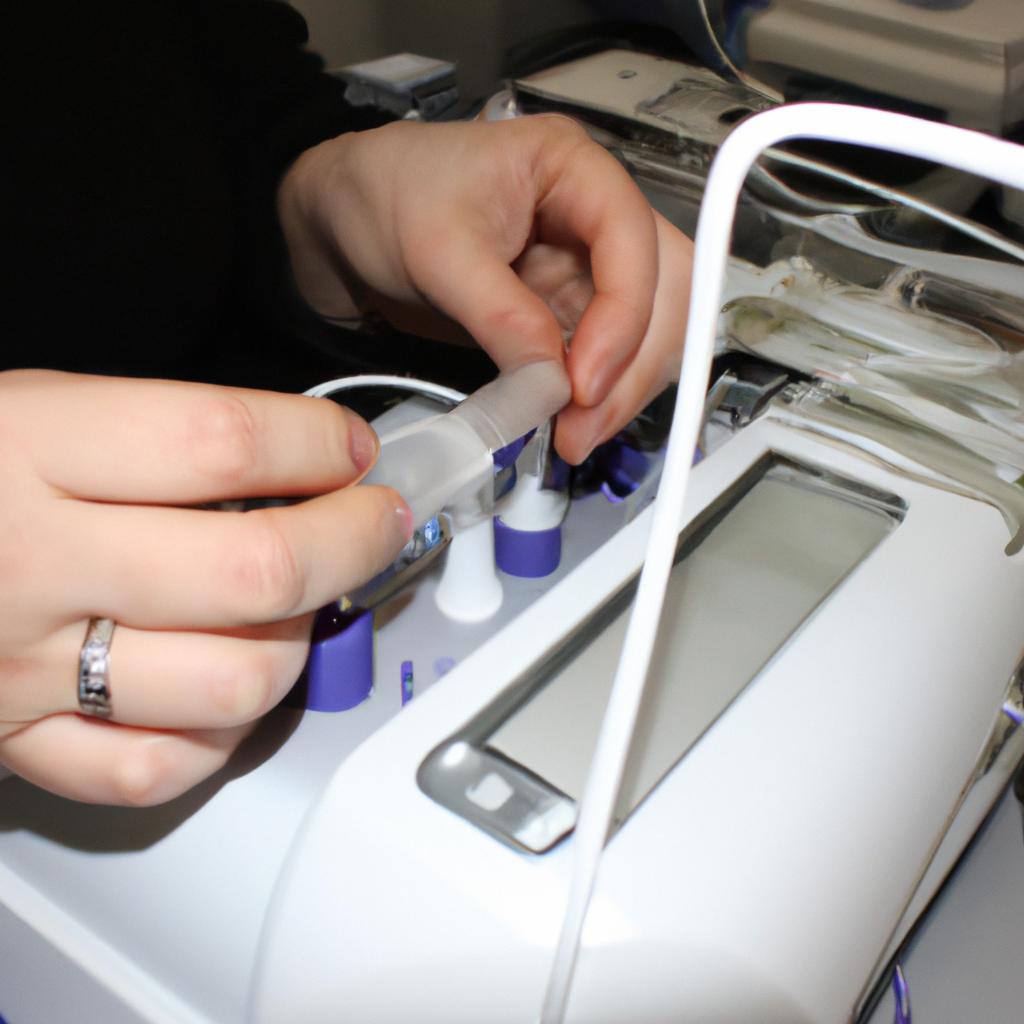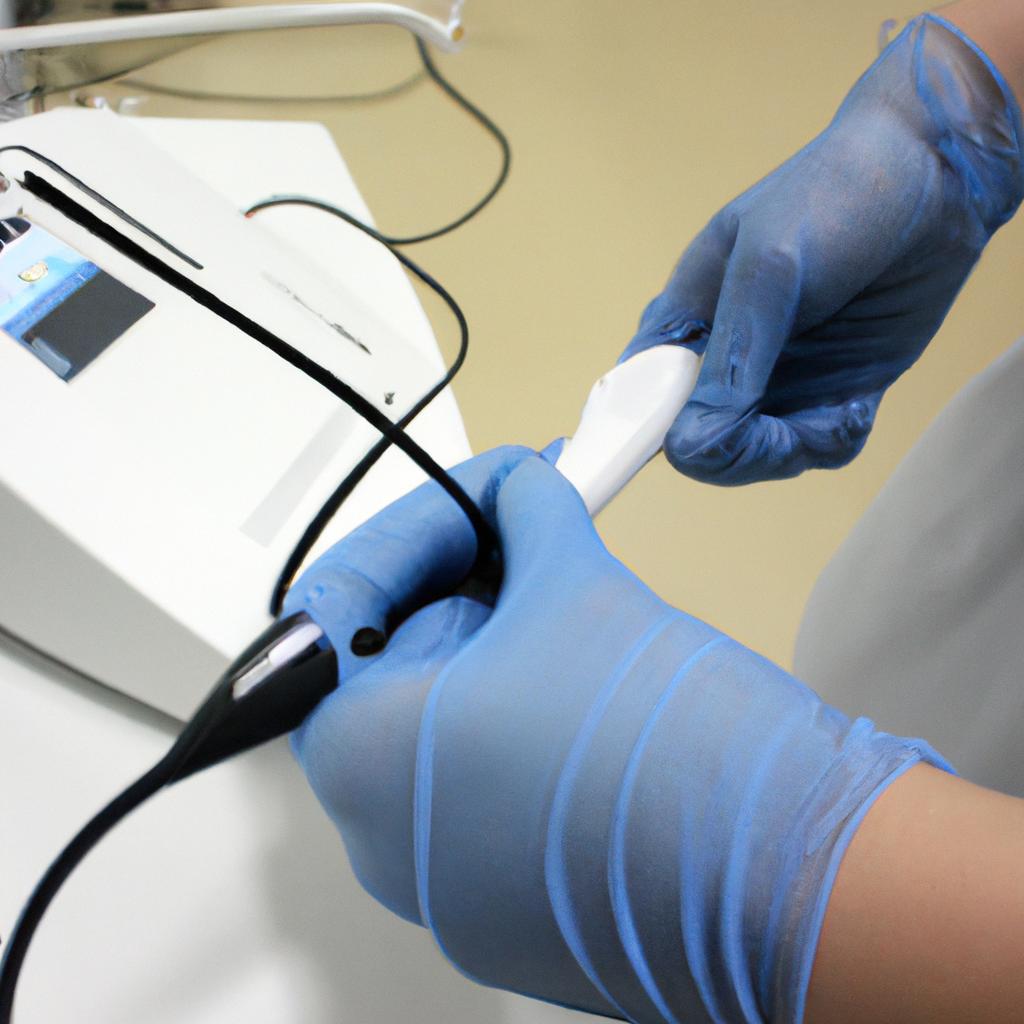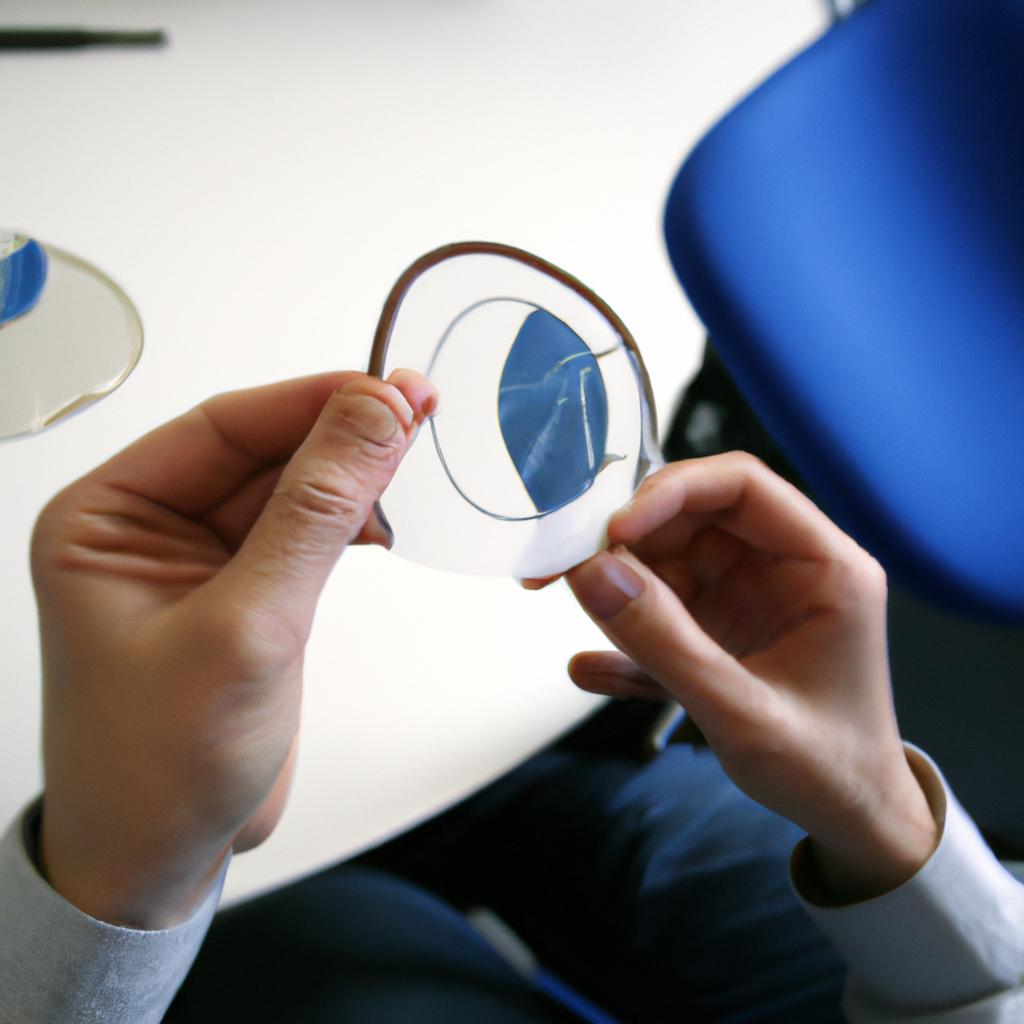The field of medicine is constantly evolving, with advancements in technology driving innovation and improving patient care. One crucial aspect of this evolution is the design and development of medical devices that aid in diagnosis, treatment, and monitoring of various health conditions. Prototyping plays a vital role in streamlining engineering processes for medical device design, allowing for efficient testing and validation before final production.
For instance, consider the case study of the development of an advanced prosthetic limb. Traditionally, designing such complex devices involved multiple iterations of manual fabrication and adjustments based on trial and error. This lengthy process not only consumed excessive time but also led to suboptimal outcomes. However, by implementing prototyping techniques, engineers can now create virtual or physical models that closely mimic the functionality and characteristics of the final product. These prototypes enable comprehensive evaluation and refinement at early stages, minimizing errors and reducing overall development time.
In addition to saving time, prototyping offers numerous other benefits in medical device design. By visualizing ideas through tangible representations, designers can effectively communicate their concepts to stakeholders and gather valuable feedback for further improvements. Moreover, rapid prototyping methods allow quick iteration cycles to address any shortcomings identified during testing phases. This iterative approach ensures that potential issues are addressed early on, leading to enhanced patient safety and user experience.
Furthermore, prototyping facilitates collaboration among multidisciplinary teams involved in medical device development. Engineers, designers, clinicians, and end-users can all contribute their expertise during the prototyping process, leading to a more comprehensive and well-rounded final product. This collaborative approach helps ensure that the device meets the needs of both healthcare professionals and patients.
Prototyping also enables cost-effective design iterations. By identifying design flaws or areas for improvement early on, engineers can make necessary adjustments before investing significant resources into manufacturing processes. This iterative approach minimizes the risk of costly redesigns or recalls down the line.
In summary, prototyping is a crucial tool in medical device design as it allows for efficient testing, validation, and refinement of concepts before final production. It saves time, enhances patient safety and user experience, promotes collaboration among team members, and helps minimize costs associated with design iterations. As technology continues to advance, prototyping techniques will play an increasingly essential role in driving innovation in the field of medicine.
The Importance of Prototyping in Medical Device Development
Prototyping plays a crucial role in the development of medical devices, enabling engineers and designers to iterate and refine their designs before moving into production. By creating tangible representations of their ideas, prototyping allows developers to identify design flaws, improve functionality, and ensure safety.
To illustrate this point, consider the case of a team developing an innovative prosthetic limb that incorporates advanced sensor technology. Through prototyping, they were able to test different materials for comfort and durability, evaluate the accuracy of the sensors’ readings, and optimize the overall fit and performance of the device. Without this iterative process, it would have been challenging to address these issues effectively.
One key advantage of prototyping is its ability to elicit emotional responses from both users and stakeholders. A well-crafted prototype can evoke empathy by simulating real-world scenarios or demonstrating how the device will enhance patients’ quality of life. For instance:
- Improved mobility: Imagine a person with limited mobility being able to walk again with the help of a new assistive device.
- Enhanced patient experience: Visualize a patient undergoing less invasive procedures thanks to a smaller, more ergonomic medical tool.
- Reduced discomfort: Envision a child experiencing less pain during injections due to an optimized needle design.
- Streamlined workflow: Picture healthcare professionals using an intuitive interface on a medical device that simplifies their tasks while ensuring accurate results.
Table: Emotional Impact Examples
| Emotion | Example |
|---|---|
| Happiness | Improved mobility |
| Satisfaction | Enhanced patient experience |
| Comfort | Reduced discomfort |
| Efficiency | Streamlined workflow |
In summary, embracing prototyping as an integral part of medical device development offers numerous benefits. It enables identification and resolution of design issues early on in the process through iterative testing. Moreover, it has the potential to generate emotional responses from various stakeholders by showcasing improved outcomes and enhanced user experiences. By recognizing the significance of prototyping, developers can ensure that their medical devices meet both functional requirements and emotional needs.
Moving forward, this section will explore methods for streamlining the engineering process in medical device prototyping, further enhancing efficiency and effectiveness while maintaining the integrity of the design.
Streamlining the Engineering Process for Medical Device Prototyping
Streamlining the engineering process for medical device prototyping is crucial in ensuring efficient and effective product development. By implementing streamlined approaches, engineers can optimize their workflow, reduce costs, and accelerate the time to market for new medical devices. One case study that highlights the benefits of this approach involves the design and development of a wearable glucose monitoring device.
The engineers responsible for developing this device utilized a streamlined engineering process from concept to prototype. Initially, they conducted extensive research on existing glucose monitoring technologies and identified key areas that needed improvement. Through iterative prototyping, they refined their design by incorporating user feedback and addressing technical challenges such as power consumption and accuracy.
- Enhanced patient experience: Streamlined prototyping allows for faster iterations and more frequent user testing, leading to improved usability and comfort.
- Cost savings: Efficient prototyping reduces overall development costs by identifying potential issues early on, minimizing costly mistakes during later stages.
- Accelerated innovation: A streamlined process enables quicker exploration of ideas, fostering innovation by encouraging experimentation and risk-taking.
- Increased market competitiveness: Rapid iteration cycles allow companies to bring superior products to market faster than competitors.
Additionally, employing tables within academic writing can be an effective way to present information clearly. Here is a three-column table highlighting various aspects involved in streamlining the engineering process for medical device prototyping:
| Aspects | Benefits | Examples |
|---|---|---|
| Iterative Prototyping | Improved designs | User feedback |
| User Testing | Enhanced usability | Focus groups |
| Risk Assessment | Reduced failure rates | Simulations |
| Collaboration | Cross-functional input | Engineering teams |
In summary, streamlining the engineering process for medical device prototyping offers numerous advantages ranging from enhanced patient experience to increased market competitiveness. By leveraging a streamlined approach, engineers can optimize their workflow and produce high-quality medical devices efficiently. This sets the stage for exploring key steps in efficiently prototyping medical devices, which will be detailed in the subsequent section.
Key Steps in Efficiently Prototyping Medical Devices
The engineering process for medical device prototyping plays a crucial role in ensuring the successful development of innovative and effective medical devices. By streamlining this process, engineers can significantly enhance efficiency, reduce costs, and accelerate time-to-market. This section explores key strategies and techniques that enable a streamlined approach to medical device prototyping.
To illustrate the benefits of streamlining the engineering process, let’s consider an example: designing a new prosthetic limb. Traditionally, developing such a complex medical device involved numerous stages, including concept generation, detailed design, prototype fabrication, testing, and refinement. Each stage required extensive manual effort and significant time investment. However, by adopting efficient methodologies like concurrent engineering or agile development approaches, engineers can now compress these stages into shorter timelines without compromising quality.
Efficiently prototyping medical devices involves several key steps:
- Requirements gathering: Clearly defining user needs and desired functionality is critical before initiating any design work. This step ensures that the resulting prototypes align with end-user expectations.
- Conceptualization and modeling: Utilizing computer-aided design (CAD) software allows engineers to create accurate 3D models of their designs rapidly. This enables early visualization of concepts and facilitates iterative improvements.
- Rapid prototyping techniques: Leveraging advanced technologies like 3D printing allows engineers to quickly fabricate physical prototypes from digital designs. These rapid prototyping methods dramatically reduce production lead times compared to traditional manufacturing processes.
- Testing and validation: Thoroughly evaluating prototypes against predefined requirements helps identify potential issues before moving forward in the development cycle. This iterative feedback loop ensures continuous improvement throughout the prototyping phase.
By implementing these steps effectively within a streamlined engineering process, organizations can achieve enhanced productivity while maintaining high-quality standards.
Transitioning from efficient medical device prototyping practices naturally leads us to explore the utilization of rapid prototyping technologies in the field of medical engineering. This next section will delve into the various cutting-edge technologies and techniques that enable engineers to accelerate the development cycle while ensuring precision and reliability in medical device design.
Utilizing Rapid Prototyping Technologies in Medical Engineering
Transitioning from the previous section discussing key steps in efficiently prototyping medical devices, we now turn our attention to the utilization of rapid prototyping technologies in medical engineering. To illustrate its practical application, let us consider a hypothetical scenario involving the design of an innovative prosthetic limb.
Imagine a team of engineers tasked with developing a new prosthetic arm that incorporates advanced motor control and sensory feedback systems. In order to streamline their engineering process and ensure optimal functionality, they decide to employ rapid prototyping technologies. By utilizing these cutting-edge methods, they are able to quickly produce physical models that closely resemble the final product, allowing for iterative improvements based on user feedback.
The benefits of incorporating rapid prototyping technologies into medical device design extend beyond just time efficiency. Here are some key advantages:
- Enhanced Design Validation: Rapid prototyping enables engineers to physically test and evaluate various design iterations before committing to production. This validation process helps identify potential flaws or areas for improvement early on, reducing costly revisions down the line.
- Improved Collaboration: With physical prototypes readily available, interdisciplinary teams can collaborate more effectively by visualizing and discussing design concepts together. This facilitates efficient communication among stakeholders, leading to better-informed decision-making throughout the development process.
- Patient-Centric Approach: Rapid prototyping allows for greater patient involvement in the design phase. By gathering real-time feedback from end-users during prototype testing, engineers can tailor their designs to meet specific patient needs and preferences more accurately.
- Cost Reduction: Identifying design issues earlier through rapid prototyping minimizes both material waste and manufacturing expenses associated with multiple rounds of modifications. Ultimately, this leads to significant cost savings over traditional trial-and-error approaches.
To further emphasize the advantages mentioned above, consider Table 1 below which compares traditional prototyping methods with rapid prototyping techniques in terms of cost-effectiveness, collaboration opportunities, and design validation capabilities:
Table 1: Comparison between Traditional Prototyping Methods and Rapid Prototyping Techniques
| Criteria | Traditional Prototyping Methods | Rapid Prototyping Techniques |
|---|---|---|
| Cost-effectiveness | High | Moderate |
| Collaboration Opportunities | Limited | Extensive |
| Design Validation Capabilities | Time-consuming | Efficient |
Through the integration of rapid prototyping technologies, medical engineering teams can streamline their processes, enhance collaboration, and reduce costs. In the subsequent section, we will address some challenges that arise during the prototyping phase in medical device design.
Transitioning into addressing challenges in prototyping for medical device design, it is important to recognize the potential obstacles faced by engineers as they strive to develop innovative solutions for healthcare needs.
Addressing Challenges in Prototyping for Medical Device Design
Utilizing Rapid Prototyping Technologies in Medical Engineering has revolutionized the process of medical device design. By employing these advanced techniques, engineers are able to streamline and accelerate the development cycle, ultimately leading to improved patient care. To further explore the benefits and challenges associated with prototyping in medical device design, this section will delve into some specific examples and discuss key considerations.
One compelling case study that exemplifies the impact of rapid prototyping technologies is the development of a prosthetic limb for amputees. Traditionally, designing and manufacturing bespoke prosthetics required extensive time and resources. However, through 3D printing technology, engineers can now rapidly create customized prototypes based on patient-specific anatomical data. This enables iterative testing and refinement, resulting in more comfortable and functional prostheses that better meet patients’ needs.
When utilizing rapid prototyping technologies in medical engineering, several important factors should be considered:
- Material Selection: The choice of materials used during prototyping plays a critical role in determining the functionality and usability of the final product. Factors such as biocompatibility, durability, and ease of sterilization must be carefully evaluated.
- Regulatory Compliance: Medical devices must adhere to stringent regulatory guidelines to ensure safety and efficacy. Incorporating compliance considerations early in the prototyping phase helps identify potential issues before significant investments have been made.
- Cost Efficiency: While rapid prototyping offers numerous advantages, it is essential to balance cost-effectiveness with quality. Careful evaluation of different prototyping methods and materials allows for optimal resource allocation.
- User-Centered Design: Involving end-users throughout the prototyping process is vital for developing devices that meet their specific needs. Continuous feedback from healthcare professionals and patients ensures that prototypes address real-world challenges effectively.
To provide a visual representation of these considerations, consider Table 1 below:
| Consideration | Importance | Example |
|---|---|---|
| Material Selection | High | Biocompatible materials |
| Regulatory Compliance | Very high | FDA, CE marking |
| Cost Efficiency | Medium | Affordable production |
| User-Centered Design | High | Patient feedback |
The integration of these considerations into the prototyping phase not only improves the efficiency and effectiveness of medical device design but also enhances patient outcomes. As technology continues to advance, future trends in prototyping for medical engineering are poised to further revolutionize this field.
Transitioning into the subsequent section on Future Trends in Prototyping for Medical Engineering, it is important to explore emerging technologies that hold promise for advancing the field even further. By harnessing cutting-edge techniques such as bioprinting and artificial intelligence, engineers can unlock new possibilities in designing innovative medical devices.
Future Trends in Prototyping for Medical Engineering
Streamlining Engineering in Medicine: Advancements in Prototyping for Medical Device Design
Transitioning from the previous section’s discussion on addressing challenges in prototyping for medical device design, this section delves into future trends that are emerging to streamline engineering practices in medicine. One example of such advancements is the integration of virtual reality (VR) and augmented reality (AR) technologies into the prototyping process.
With VR and AR, engineers can create immersive simulations and visualize medical devices before they are physically built. This technology allows them to assess functionality, ergonomics, and user experience more efficiently, reducing the need for multiple physical prototypes. For instance, a hypothetical case study involving the design of an innovative surgical tool could benefit from VR/AR prototyping. Surgeons would be able to interact with a virtual representation of the instrument, providing feedback on its usability and suggesting improvements without needing physical samples.
To further optimize efficiency in medical device design, several key strategies are being implemented:
- Collaboration between engineers and healthcare professionals: By involving various stakeholders early in the prototyping process, valuable insights can be gained regarding clinical needs, patient safety requirements, and ergonomic considerations.
- Utilization of rapid prototyping techniques: 3D printing has revolutionized prototype production by enabling fast iteration cycles and cost-effective manufacturing. This technique allows engineers to quickly test different designs and functionalities before moving forward with full-scale production.
- Integration of artificial intelligence (AI): AI algorithms can analyze large sets of data collected during clinical trials or device usage to identify patterns or potential issues. By leveraging AI capabilities, engineers can enhance their understanding of how devices perform under real-life conditions while identifying opportunities for improvement.
- Implementation of digital twin technology: Digital twins provide a virtual replica of physical devices allowing continuous monitoring and analysis throughout their lifecycle. Engineers can use digital twins as testing grounds for modifications or upgrades without disrupting ongoing operations.
Embracing these future trends will not only expedite the prototyping process but also enhance the overall quality and safety of medical devices. By leveraging VR/AR, collaborating with stakeholders, utilizing rapid prototyping techniques, integrating AI algorithms, and implementing digital twins, engineers can achieve more efficient designs that meet the evolving needs of healthcare professionals and patients alike.
| Advancements in Prototyping for Medical Device Design |
|---|
| Collaboration between engineers and healthcare professionals |
| Implementation of digital twin technology |
In summary, as the field of engineering in medicine continues to evolve, so too does the approach to prototyping. Leveraging emerging technologies such as VR/AR, along with strategies like collaboration between engineers and healthcare professionals, rapid prototyping techniques, integration of AI algorithms, and implementation of digital twin technology will undoubtedly streamline the design process while ensuring optimal performance and usability of medical devices. By embracing these advancements, we can pave the way for safer and more effective innovations in healthcare.




